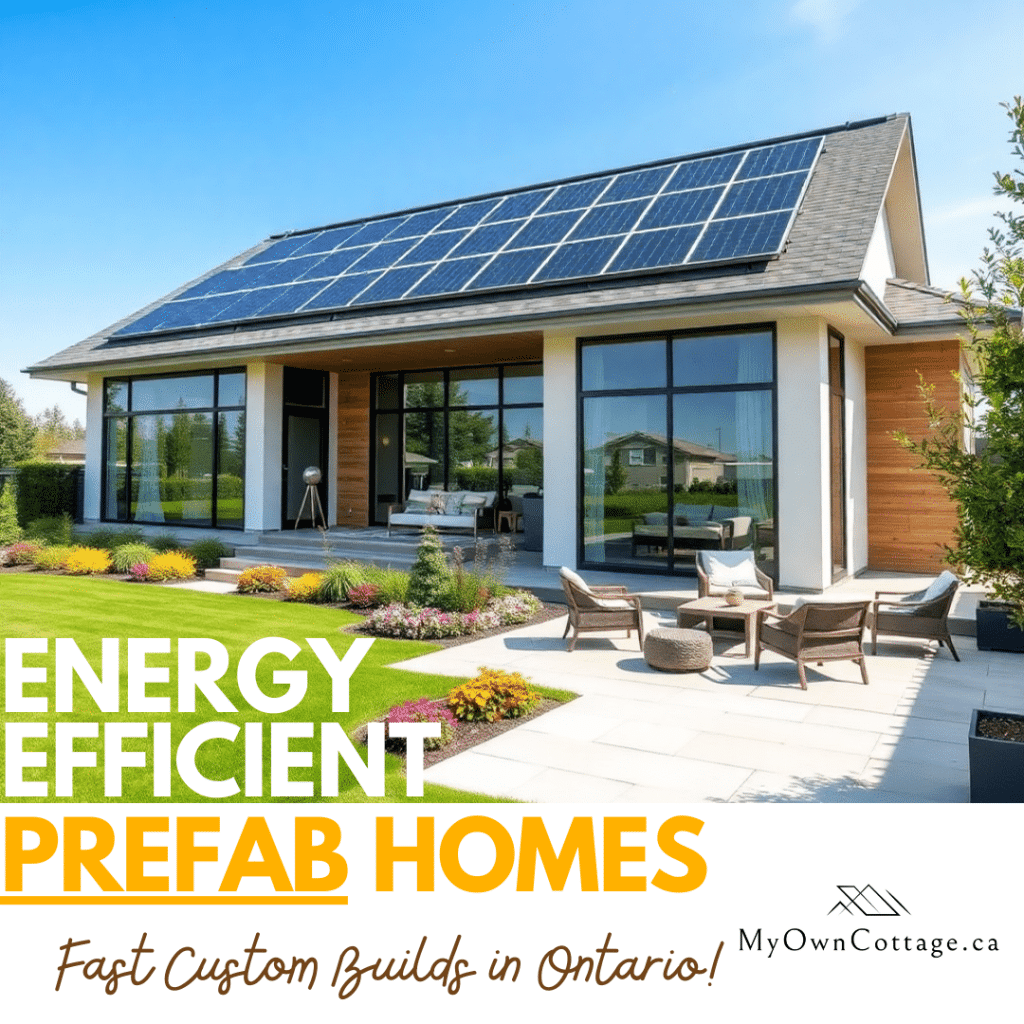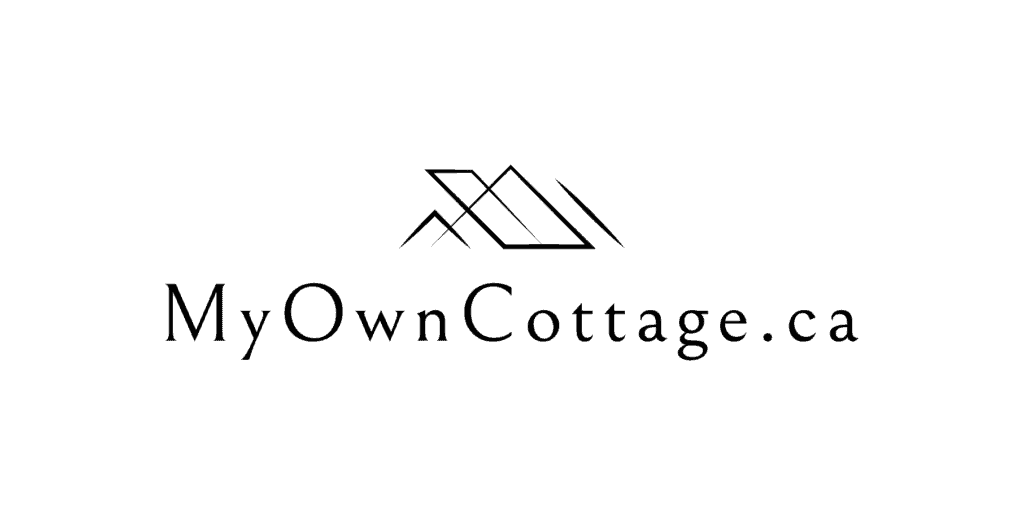Do Energy-Efficient Prefab Homes Cost More Upfront?
📅 Last updated: September 10th, 2025
✍️ Written by prefab building specialists at My Own Cottage
Yes—energy-efficient prefab homes typically cost more upfront in Ontario.
The premium comes from advanced materials, superior insulation, high-performance windows/doors, and efficient HVAC systems designed to cut long-term energy use.
Why buyers still choose them:
Lower monthly energy bills
Government rebates and incentives for green upgrades
Higher resale value as demand for energy-efficient housing grows
In most cases, the long-term financial and environmental benefits outweigh the initial price difference.
Energy-Efficient Prefab Homes vs. Standard Models: Upfront Costs
This guide breaks down the costs of prefab homes in Ontario, comparing standard models with energy-efficient options.
You’ll see why sustainable prefab homes are a smart long-term investment thanks to utility savings, rebates, and stronger resale value.
👉 For a detailed look at base pricing, check out our guide on the cost per square foot of prefab homes in Ontario.
🔎 Energy-Efficient Prefab Home Features in Ontario
Energy-efficient prefab homes are built to reduce energy use and lower environmental impact. They achieve this through high-performance design and materials tailored to Ontario’s climate.
Common features include:
High-performance insulation – keeps homes warmer in winter and cooler in summer
Triple-glazed windows and airtight doors – prevent drafts and improve comfort
Renewable-ready infrastructure – wiring and roof systems designed for solar panel integration
Efficient HVAC systems – optimized to handle Ontario’s hot summers and cold winters

Why Ontario Homebuyers Choose Energy-Efficient Prefab Homes
Together, these features not only help homeowners save on energy costs but also create more comfortable living spaces while reducing their environmental footprint.
In Ontario, demand for energy-efficient prefab homes is rising. Homebuyers increasingly value:
Lower utility bills from reduced heating and cooling loads
Year-round comfort via better temperature control and airtightness
Sustainability and smaller carbon footprints
According to the Canada Mortgage and Housing Corporation (CMHC), sustainability is a key driver of housing innovation in Canada, with prefab playing a growing role in Ontario’s green housing future.
As an example, prefab home costs in rural Ontario can be significantly diminished over time by the raw value of energy-efficient designs.
💰 Prefab Home Cost Drivers in Ontario: Energy-Efficient vs. Standard
Energy-efficient prefab homes — often referred to as modular homes in Ontario — usually cost more upfront than standard models due to premium components and tighter construction.
For buyers researching modular home pricing in Ontario, these premiums typically add 5–15% to the total build cost.
Typical cost drivers:
High-performance insulation: +$5–$15 per sq. ft.
Energy-efficient windows & doors: +$10,000–$20,000 per home
Renewable-ready (solar-prep): +$5,000–$10,000
Overall premium: About 5–15% above standard prefab options.
For a detailed look at base pricing, check out our guide on the cost per square foot of prefab homes in Ontario and learn more about “how size affects price per square foot in Ontario.”
Here’s how owners recoup the difference:
Lower monthly utility bills
Federal/provincial rebates and incentives
Higher property value at resale
Note: These costs differ from traditional construction methods — learn more in our prefab homes cost comparison with traditional homes guide.
Prefab Home ROI in Ontario: Long-Term Savings vs. Upfront Costs
The true financial benefit — or green prefab home ROI — becomes clear over time, as energy savings and rebates outweigh the upfront investment.
Some homeowners may even compare whether it’s cheaper to build a prefab home or buy an existing house in Ontario.
Typical returns include:
💡 Energy savings: $100–$300 per month on utility bills
📆 Break-even point: 7–12 years, depending on home size and energy use
📈 Resale value boost: Up to 10% higher than standard prefab homes
🏠 Real Example:
A family in Kitchener, Ontario, invested $25,000 more upfront for an energy-efficient modular home. Over 10 years, they saved nearly $30,000 in energy costs. By year 11, their return on investment turned positive—while also enjoying lower bills and greater comfort throughout.
🚧 Key Lesson: Be sure to budget for permits and utility hookups ahead of time.
Prefab vs. Traditional Homes: Cost & ROI in Ontario
🔹 Upfront Cost
Prefab Homes: 5–15% higher than standard prefab; ~$200–$450 per sq. ft.
Traditional Homes: Wide range; ~$250–$500 per sq. ft.
🔹 Construction Speed
Prefab Homes: 30–50% faster (factory-built modules). Be sure to learn more about prefab construction timelines and labor costs.
Traditional Homes: Longer timelines; subject to weather delays.
🔹 Energy Efficiency
Prefab Homes: High-performance insulation, HVAC, triple-glazed windows; often net-zero ready.
Traditional Homes: Meets building code; upgrades required for higher efficiency.
🔹 Monthly Energy Bills
Prefab Homes: $100–$300 lower per month.
Traditional Homes: Higher monthly costs due to less efficient systems.
🔹 ROI (Break-even Point)
Prefab Homes: 7–12 years via savings + rebates.
Traditional Homes: Less predictable; depends on efficiency upgrades.
🔹 Resale Value
Prefab Homes: 5–10% higher resale value with certifications (net-zero, passive house).
Traditional Homes: Variable; less demand for non-efficient homes.
Get key advice on home size with our dedicated guide are small prefab homes more expensive per square foot in Ontario.
🎁 Incentives, Rebates, and Financing in Ontario
Many of our clients ask us how to pay for a prefab home.
For starters, you can reduce your net upfront cost with available programs:
Canada Greener Homes Grant: up to $5,000 for efficiency upgrades
Enbridge Energy Rebate Program: rebates on insulation and HVAC
Low-interest loans through the Canada Greener Homes Loan program
Local municipal programs (varies by region)
These Ontario prefab home rebates can significantly reduce your net investment, making energy-efficient construction more accessible.
Many prefab builders (including My Own Cottage) help you navigate and maximize eligible rebates.
🔍 Additional Costs for Prefab Homes in Ontario
While energy-efficient features are a major cost driver, several additional factors also influence the total price of a prefab home in Ontario:
Land preparation & permits – costs vary widely depending on local municipal requirements and site conditions
Custom design vs. standard models – bespoke layouts, finishes, and upgrades increase overall costs
Builder expertise – experienced green builders may charge more upfront but often deliver higher quality and better long-term ROI
👉 For a detailed breakdown, explore our Ontario prefab cost per square foot guide.
🤔 Are Energy-Efficient Prefab Homes Worth the Extra Cost in Ontario?
Yes—while energy-efficient prefab homes cost more upfront, they deliver long-term value through lower utility bills, improved comfort, and higher resale potential.
For homeowners planning to stay at least 7–10 years, these homes represent one of the smartest and most future-ready housing investments in Ontario. 💚🏡
With energy savings, government rebates, and increasing buyer demand for sustainable housing, energy-efficient prefab homes are proving to be among the most cost-effective housing options over time.
👉 Ready to explore your options?
Simply book a free consultation, call us directly or view our design catalogue today.
🧑💼 Request a Free Consultation
📲 Call Us Directly: (705) 345-9337
🏘️ View Our Design Catalogue
✅ Ontario-Built | ⚡ Energy-Efficient | 🏡 Fully Customizable | 🚚 Fast Delivery
Alternatively, for your convenience, you can also simply fill out the contact form below and we’ll get back to you soon! 👇
FAQ: Energy-Efficient Prefab Home Cost & Upfront Pricing
Do energy-efficient prefab homes cost more upfront?
Yes. Energy-efficient prefab homes typically cost more upfront due to advanced insulation, high-performance windows, and precise airtight construction.
Why do energy-efficient prefab homes cost more upfront?
They use premium materials, efficient HVAC systems, and rigorous construction standards like passive house or net-zero, which raise initial costs.
How much more expensive are energy-efficient prefab homes?
In Ontario, they average 5–15% higher than standard prefab homes, or about $10–$25 extra per square foot.
What’s the average cost per square foot for prefab homes in Ontario?
Prefab homes in Ontario generally range from $200–$450 per square foot turnkey, depending on finishes, land prep, and energy features.
Are energy-efficient prefab homes worth the extra cost?
Yes. Homeowners usually recoup the premium within 7–12 years through energy savings, rebates, and higher resale value.
When do energy-efficient prefab homes pay for themselves?
Most Ontario buyers reach break-even within a decade, thanks to lower utility bills and available rebates.
What are the long-term benefits of energy-efficient prefab homes?
They offer lower monthly energy bills, improved comfort, reduced carbon footprint, and better resilience against extreme weather.
Do all prefab homes in Ontario come energy-efficient by default?
No. Standard prefab homes are affordable, but energy efficiency is usually an upgrade that buyers select as a customization.
How do energy-efficient prefab homes compare to traditional homes?
They may cost slightly more upfront but deliver faster build times, stricter quality control, and predictable energy savings than stick-built homes.
Can you get rebates for energy-efficient prefab homes in Ontario?
Yes. Programs like the Canada Greener Homes Grant and Enbridge Home Efficiency Rebate Plus help offset upfront costs.
What incentives are available for prefab homes in Ontario?
Ontario residents can access federal grants, low-interest loans, and local rebate programs to reduce the cost of green prefab upgrades.
Do prefab homes meet the Ontario Building Code?
Yes. Most modular homes are built to CSA A277 standards, which ensure compliance with the Ontario Building Code.
Do prefab homes in Ontario come with a warranty?
Yes. Many qualify for Tarion warranty coverage, which protects buyers with multi-year statutory guarantees.
How long does it take for energy savings to cover upfront costs?
Typically 7–12 years, depending on household energy use, rebate eligibility, and home performance.
Are prefab homes cheaper than traditional homes in Ontario?
Often yes. Prefab homes offer cost predictability and faster build times, though site prep and customization affect total price.
Do energy-efficient prefab homes hold resale value?
Yes. Homes with low operating costs and energy certifications often achieve higher resale premiums in Ontario’s housing market.
Can prefab homes qualify as net-zero or passive house?
Yes. Many Ontario builders now offer net-zero ready and passive-house prefab models, though these add to upfront costs.
What factors most affect the cost of an energy-efficient prefab home?
Key factors include insulation levels, glazing package, HVAC system type, site prep, and customization choices.
🛡️ Verified Third-Party Resources
For added confidence and transparency, here are trusted external sources that support modular homebuilding in Ontario:
Ontario Building Code (O. Reg. 332/12)
Official provincial regulations that govern modular and factory-built homes.Tarion Warranty Corporation
Provides home warranty coverage and builder licensing in Ontario.Canadian Home Builders’ Association (CHBA)
National organization supporting residential construction, modular certification, and best practices.CMHC – Canada Mortgage and Housing Corporation
Federal housing authority offering insights on modular housing affordability, financing, and energy efficiency.Statistics Canada: Housing Data
Data-driven research on Canadian housing trends, ownership, affordability, and construction.


